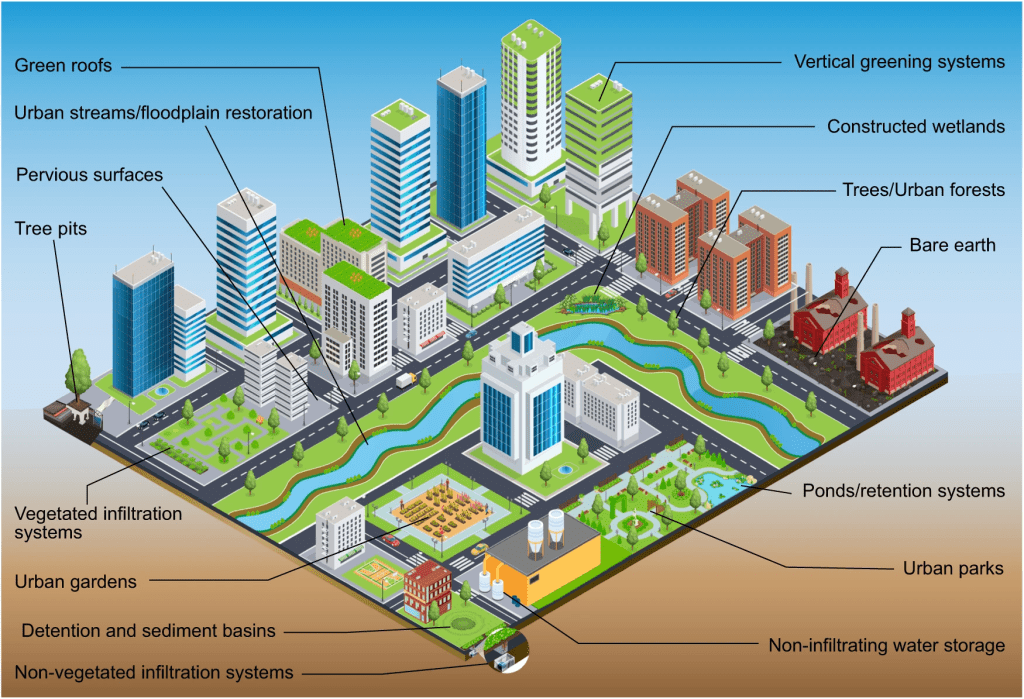Introduction
Nature is one of our greatest assets in addressing the challenges posed by climate change. As urban areas increasingly face the threat of flooding, it is essential that we turn to nature for solutions. Nature-based solutions such as green infrastructure offer effective, sustainable ways to manage stormwater while also delivering multiple benefits. These solutions help reduce urban flooding, improve water quality, and strengthen climate resilience. By embracing nature-based stormwater solutions, we can better adapt to our evolving climate and address the growing challenges of stormwater management (de Oliveira, 2025).
What Are Nature-Based Solutions and Green Infrastructure?
According to the 5th United Nations Environment Assembly (UNEA 5.2), nature-based solutions (NbS) are actions aimed at protecting, conserving, restoring, and sustainably managing natural or modified terrestrial, freshwater, coastal, and marine ecosystems, which address social, economic, and environmental challenges effectively and adaptively, while simultaneously providing human well-being, ecosystem services, resilience, and biodiversity benefits (UN Environment Programme, n.d.). In other words, NbS are solutions that are inspired and supported by nature, which are cost-effective, simultaneously providing environmental, social, and economic benefits to help build resilience (European Commission, n.d.).
NbS are typically classified under blue or green infrastructure or the combination of both (blue-green infrastructure). Blue infrastructure refers to water-centred, ecosystem-based solutions that enhance environmental quality and support community well-being. It includes features such as urban ponds, rain gardens, wetlands, canals, and other natural or engineered water systems that help manage stormwater, improve biodiversity, and create healthier urban environments (De Silva, 2022). Whereas, green infrastructure refers to interconnected networks of green areas that include natural, semi-natural, or artificial ecological systems. These networks offer advantages including wildlife conservation, stormwater management, and recreational opportunities for people (Monteiro et al., 2020). Common types of green infrastructure include green roofs, bioswales, urban trees, permeable pavements and green streets and alleys (United States Environmental Protection Agency, n.d.).

Types of Green Infrastructure.
Source: Cook et al. (2024)
Approaches to Implementing Nature-Based Stormwater Solutions
The adoption of nature-based stormwater solutions involves integrating green infrastructure into urban environments to manage runoff sustainably (Flood Control, 2024). Maintaining or simulating a site’s natural hydrology and ability to absorb and filter stormwater runoff is the fundamental purpose of nature-based stormwater management. This can be accomplished by the use of permeable pavers, disconnected impervious surfaces, bioretention, and extensive watershed restoration (North Carolina Coastal Federation, n.d.).
Implementing nature-based stormwater solutions involves designing infrastructure that works with natural processes to manage runoff sustainably. Key approaches include site-scale green infrastructure, community-scale planning, policy integration, and ongoing maintenance strategies. At the site scale, tools such as bioretention systems (e.g. rain gardens), green roofs, permeable pavements, and vegetated swales allow for the infiltration, filtration, and evapotranspiration of stormwater at or near its source (United States Environmental Protection Agency, n.d.). Urban planners and developers often use these practices to retrofit existing developments or shape sustainable new growth.
At the community or watershed scale, approaches include stream restoration, urban tree canopy expansion, wetland rehabilitation, and floodplain reconnection. These large-scale efforts improve ecosystem services and reduce downstream flood risks (USDA Forest Service, 2016). Successful implementation needs supportive policies like utility fees, green building incentives, and zoning codes favouring green infrastructure. Public engagement and cross-sector collaboration are essential to ensure long-term stewardship, funding, and maintenance. By integrating these methods, cities can increase resilience to climate impacts while enhancing community health and ecological integrity.

Green Infrastructure in Action.
Source: United States Environmental Protection Agency (n.d.)
How Green Infrastructure Reduces Urban Flooding and Improves Water Quality
In urban flood management, green infrastructure is increasingly recognised for reducing peak runoff and total water volume. It also provides numerous environmental and urban benefits (Ali et al., 2025). Green Infrastructure primarily reduces urban flooding via water retention and detention. During heavy or moderate rainfall, water is stored and gradually released into downstream watercourses, the sewage system, or buildings not connected to the sewer system (Pereira at al., 2019).
The effectiveness of rainwater tanks and infiltration trenches as integrated green infrastructure systems was assessed by Schubert et al. (2017) in a small urban catchment in Melbourne. The results showed that with the existing green infrastructure and a storm duration of 3 hours or less, the downstream flooded area decreased by 29%. Full green infrastructure deployment would reduce it by 91%.
In addition, water quality is improved by green infrastructure for treatment through physical, chemical, and/or biological techniques. By removing pollutants, fertilisers, and silt before they enter nearby rivers, green infrastructure enhances the quality of the water. In fact, one of green infrastructure’s primary objectives is to improve water quality (Chandratreya, 2024).
Why Nature-Based STORMWATEr Solutions Are Essential for Climate Resilience and Sustainability
NbS are gaining recognition for addressing climate change impacts and environmental issues in urban areas. Reviews conducted worldwide have validated the effectiveness of NbS in reducing disaster risk, adapting to climate change, and promoting sustainability (Kibii et al., 2025). They provide essential services, including reducing greenhouse gas emissions, ensuring clean water access, improving air quality, and enhancing food security (Wordwide Fund, 2024).
As countries continue to face increasingly complicated climate-related challenges, NbS are a cost-effective alternative to traditional grey infrastructure. They offer long-term climate resilience and several benefits and require integrated and innovative solutions (World Bank, 2023). NbS play a fundamental role in enhancing climate resilience in urban areas while providing socio-economic benefits across multiple scales and functions. For instance, incorporating NbS into public areas can lessen the intensity of urban heat islands. It can also provide permeable surfaces to reduce flood risks, enhance soil quality, and stabilise land prone to erosion. Additionally, NbS can increase and preserve biodiversity, improve water use efficiency, lower maintenance costs, and most importantly, enhance quality of life (UN-Habitat, n.d.).

Tackling the Climate Change Crisis with Nature-Based Solutions.
Source: Williamson (2023)
In summary, nature-based stormwater solutions address flooding, heatwaves, and water scarcity in urban areas, promoting climate resilience. They offer adaptable, affordable methods for managing climate impacts while enhancing ecosystem health and community well-being. They are essential to sustainable urban climate strategies as a result of their many uses.
Practical Steps for Cities to Integrate Green Infrastructure into Urban Planning
For communities looking to manage stormwater sustainably, and increase climate resilience, incorporating green infrastructure into urban planning is crucial. To do so there are several practical steps that cities can follow to effectively implement green infrastructure strategies:
- Assess Existing Plans and Policies: Cities should begin by reviewing current planning documents, zoning codes, and municipal practices to identify opportunities for incorporating green infrastructure. Tools like the United Statees Environmental Protection Agency’s land use and green infrastructure scorecard can assist in this evaluation process (United States Environmental Protection Agency, n.d.).
- Utilise Integrated Planning: Adopting an integrated planning approach, with active community involvement, enables cities to address multiple environmental and infrastructure challenges simultaneously, leading to more inclusive and sustainable outcomes (Sustainability Directory, 2025).
- Design with Maintenance in Mind: Effective green infrastructure requires a thoughtful design that considers long-term maintenance needs. Selecting appropriate vegetation and ensuring access for maintenance activities are crucial for the longevity of green infrastructure installations (Gerlak et al., 2022).
- Establish Sustainable Funding Mechanisms: Securing dedicated funding sources such as stormwater utility fees. As well as financial incentives including tax rebates, tax breaks, and green bonds. This ensures the long-term operation and maintenance of green infrastructure systems (Georgetown Climate Center, n.d.).
Conclusion
All things considered, NbS, particularly green infrastructure, offer an efficient and sustainable stormwater management approach in cities. They reduce runoff and peak flow, minimising flooding while improving public health, biodiversity, and urban resilience. Adopting these solutions now lays the foundation for proactive, thriving communities. Investing in green systems is a step toward a healthier, more climate-resilient world.
Achieving the SDGs and how they link to Nature-Based Solutions for Stormwater Management
NbS offer sustainable approaches to managing stormwater while also supporting progress toward the Sustainable Development Goals (SDGs). These solutions help address environmental, health, and urban resilience challenges. The SDGs most directly linked to stormwater management through NbS include:
- SDG6 – Clean Water and Sanitation: Improves water quality by naturally filtering stormwater and reducing runoff pollution.
- SDG11 – Sustainable Cities and Communities: Enhances urban resilience and liveability through green infrastructure.
- SDG13 – Climate Action: Mitigates climate impacts by managing stormwater and reducing urban flooding.
Although the SDGs offer a tangible framework for improving the planet, they often fall short of driving deep, systemic change. In contrast, the foundational focus factors (FFFs) of the THRIVE Framework provide a more holistic and regenerative approach, better aligned with NbS. Moving forward, the THRIVE Framework will guide a shift beyond sustainability toward creating a planet where all life can truly thrive.
A Thrivable Framework
The THRIVE Framework is a holistic, regenerative model that integrates 12 FFFs to assess and improve thrivability, addressing both environmental and social issues beyond sustainability. By linking these principles to NbS, the framework helps create context-based strategies for stormwater management, fostering resilience and ecological restoration.
Systems Thinking helps design integrated solutions that manage stormwater while enhancing biodiversity, water quality, and climate resilience. Values-based Innovation ensures that NbS prioritise community well-being and equity in their implementation. Tackling Complex Wicked Problems, NbS offer flexible, nature-driven solutions for urban flooding and water pollution. Finally, Strong Sustainability focuses on using natural processes that restore ecosystems, ensuring long-term stormwater solutions that are both effective and sustainable.
To learn more about THRIVE’s work, visit the Website and explore how it is making a difference. You can also follow the informative Blog and Podcast series, where you can dive deeper into the latest sustainability topics. Check out the comprehensive Whitepapers for in-depth research and analysis. Join the live Webinars and interactive Workshops where expert guests from various fields share valuable insights and answer your questions in real time. Sign up for the Newsletter to stay up-to-date with upcoming events, fresh content, and exclusive opportunities.























